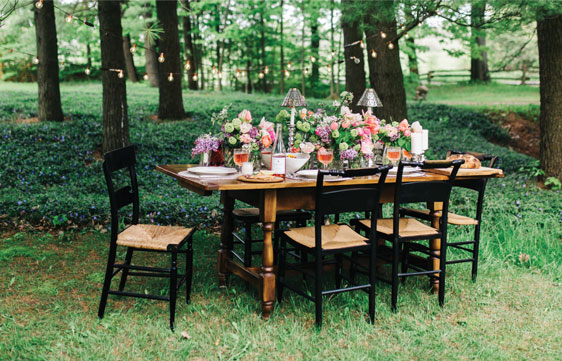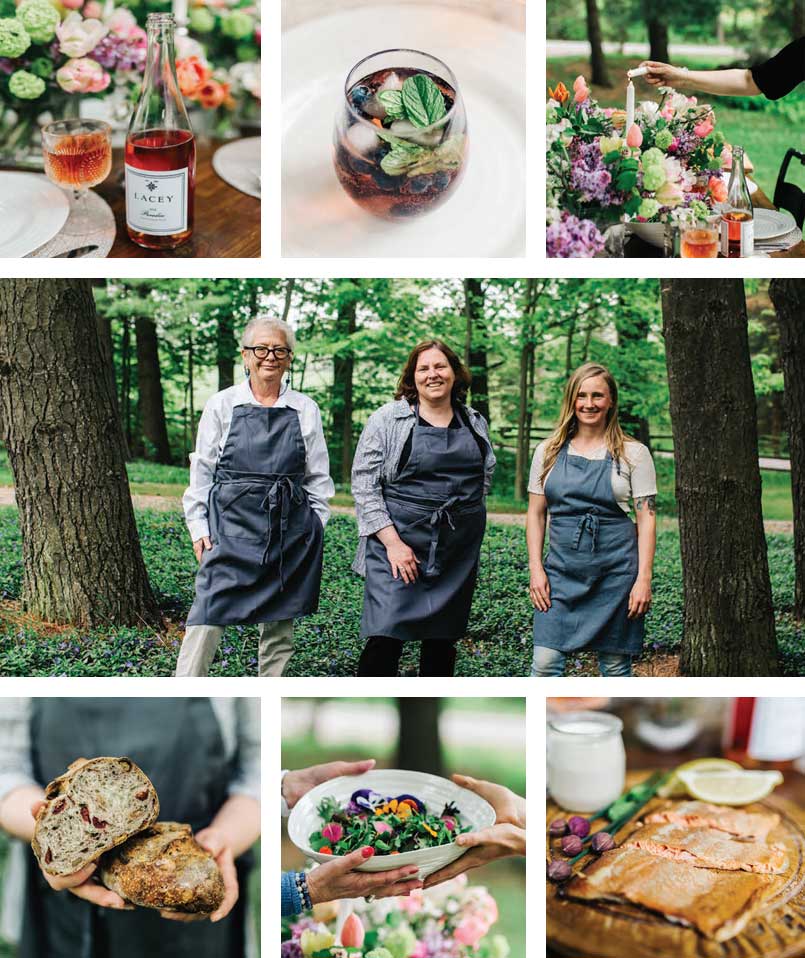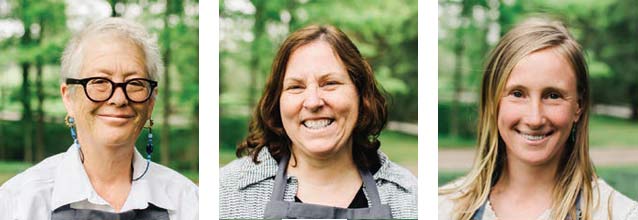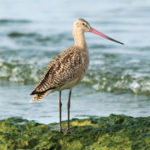


Left to right: Pam Marr, Annie Boulanger, Erin Bodashefsky
A simple, elegant outdoor dining experience that showcases the best of our local producers.
It’s three months long – give or take a few days– and it’s what we live for: summer. We take our lives outside – under sun and stars – and don’t go back in until September. And while we’re feasting on the bounty of summer, the makers, growers, and producers of Northumberland, Quinte and Prince Edward County are busy supplying us with fresh, local delicacies.
Dining al fresco is one of summer’s most indulgent pleasures – especially once the mosquitoes and blackflies have gone to bed. And the key to arranging a dinner outside is to keep things simple.
With so much stimulation – the scent of blossoms on the air, birdsong, visiting butterflies and honeybees, the cooling breeze and warming sun – outdoor entertaining is a feast for all the senses. Capitalize on what the outdoors has to offer and take it easy in the kitchen. Who wants to turn the stove on when you have a barbecue? Summer is the time to think gathering, not cooking. There are so many farm gate stands, artisans’ and farmers’ markets around, it’s easy and fun to channel your inner hunter-gatherer.
SETTING THE TABLE
Let nature be your guide. If the lilacs are in bloom, fill tea pots, jugs, and vases with sprays of the sweet branches and blooms. Forest ferns are beautiful on the table, as are peonies, roses, hydrangeas. Use whatever is in bloom in your very own garden.
Mix and match china, crystal, linens, and silverware. Antique and vintage thrift store finds are gorgeous and practical for outdoor dining – a broken dish won’t set you back more than a buck or two. Watershed country is blessed with many fantastic second hand and charity shops – just about every town has a few. Searching for unique tableware is just another excuse to go exploring! Vintage linens are lovely but can be pricey. Try using paper napkins – but first wash some stones to use as weights to hold down the napkins – and with a little magic marker, they’ll do double duty as place cards.
Tip: Not a gardener? Consider potluck flower arranging. Ask your guests to surprise you with something from their gardens.
LOCATION, LOCATION, LOCATION
If you plan to dine at the height of the day’s heat, make sure that your table is in the shade. If you’re dining at night, put the table out in the open to allow for torch flames and stargazing. If you can, string some fairy lights up.
You don’t want to be too far from the house for trips to the powder room and kitchen, and the path back to the house should be safe and visible. If it’s not lit up, set out some candles – those electronic ones won’t blow out – torches, or string some fairy lights from the door to the table.
If you have a water feature, that’s a lovely place to dine. Don’t set the table near the driveway, composter, garbage bin, or garage – smells are exaggerated at night.
WHAT TO SERVE
Summer eating and entertaining should be easy for everyone – host, and guest. Serve simple, seasonal foods – salads, smoked fish, or grilled meats – presented in a relaxed style. Good food – great food – is available everywhere throughout our region, from honey and preserves, to sweet baked goods, local, pasture-raised meats and salumi, organic veggies, lake fish, and beautiful artisan breads.
There’s no need to bake for a summer party; treats are all around us. Try fresh fruit – think Ontario strawberries – with local ice cream, or sorbet with pink bubbles. Both are elegant ways to chill out.
WHAT TO SIP
For successful summer food and wine pairings, first consider what you are serving and then consider the weather. Only the most committed of Cab Sauv fans will insist on a room-temperature glass of meaty red wine on a hot, sunny afternoon. It’s more likely your guests will crave something lighter, chilled, and lower in alcohol. Icy bubbles are always a hit – day or night – with or without food. Prince Edward County’s wineries excel at whites, rosés, sparklers, and lighter reds, such as Pinot Noir, Baco Noir, and Cabernet Franc.
But if wine isn’t your thing, with hop farms and orchards abounding, Northumberland, Quinte and Prince Edward Counties are rapidly becoming epicentres of craft beer and cider making.
Still, a very basic rule of thumb should be: grilled and charred foods call for red, everything else calls for white or rosé, and when in doubt, go with something bubbly. And always have extra glasses and a big pitcher of water on the table to keep guests hydrated.
Tip: For keeping drinks cool, use big garden totes, a wheelbarrow, or planters filled with ice.
Sources: Our plein air dinner featured Paradise, a light, sparkling rosé wine from Lacey Estates Winery and Number E Tea, a refreshing non-alcoholic alternative. Dahlia May Flower Farm created our summer-themed arrangements and The Market & Smør sent along fruit for the sangria.
Pam Marr,
Marr-Velous Smoked Fish, Port Hope
A post-production specialist for television, photography, and video, Pam spends her days in meetings and editing suites, staring at screens and aiming for digitized perfection. At night, when she goes to work with her smokers, it’s less Hollywood, more hardwood.
Pam had no regrets about moving from Hogtown and resettling in Northumberland until she couldn’t find any decent smoked salmon. But, if you can’t find what you want, make what you want! Pam did. Her friends tasted it, told her she should sell it, and now she’s selling about 20 pounds of her silky, smoky salmon and trout at the Port Hope Farmers’ Market each week.
Clocking about 25 hours a week tending her seven smokers – they need adjusting every 20 minutes – and with the tutelage from master smoker, Bob, in North Carolina, Pam is perfecting her hot and cold smoking technique. “I choose the best product I can find; the wood – cherry, alder, maple – that is from a sustainable producer in Oregon, and the fish is from native farms that don’t use chemicals, drugs, or unsustainable feed.”
Annie Boulanger,
My World Kitchen, Brighton
For the last 30 years, Annie designed clothes for a private label manufacturer. But baking was always her passion. “You know,” Annie laughs, “I thought it would be nice to finally live up to my name!” For those who spent French class behind the bleachers exploring another romantic language, boulanger means “baker”.
“I had been making bread for myself, but then I realized I had something very different, very special. I discovered that other people enjoyed it as much as I did!” So she and her father built a brick, wood-fired oven in the backyard of her Lake Ontario cottage, and at the urging of a friend, she started making pizzas. Before she knew it, that backyard was full of locals feasting on her perfectly blistered pies and loaves.
Annie’s process is long: dough is mixed on Thursday and formed on Friday; Saturday evening, she builds a raging fire in the oven and heads for bed. She’s up at one o’clock in the morning to rake out the embers and start baking loaves for the Sunday Codrington Farmers’ Market, where every last loaf will be grabbed up by discerning foodies.
Erin Bodashefsky,
Foragers Farm, Cobourg
The road to farm life in rural Ontario took Erin around the globe and back home again. She finally put down roots in the fertile soil of Northumberland County with her life partner, Tyler Davis, and Cypress, the couple’s toddler.
Trained as a vegetarian chef, Erin had been foraging since she was a teenager growing up in Oshawa. Now, within the boundaries of Headwaters Farm, Erin and Tyler tend three co-op acres of greenhouses, market gardens, and an expanse of forest for Erin to forage in.
Erin says, “Tyler said he fell in love with me because I was always foraging in the woods.” But as important as love is, the two bring entirely different skills to the project. “Tyler is a sheet metal mechanic, so he does all the building and fixing and calculating, while I’m more about the food aspect: foraging, gardening, and administrative work.” And with a 27-member CSA (Community Supported Agriculture), chefs to supply, interns, and several farmers’ markets to manage, there is a surprising amount of office work, the cure for which is more foraging – with little Cypress in tow.
Story by:
Signe Langford
Photography by:
Chantelle Watt




